When a firearm manufacturer with a reputation of producing high-quality, durable semiautomatics ventures into the under/over market, a lot of shooters will take notice. Such is the case with the new Benelli Model 828U that made a big splash at the January 2015 SHOT Show. The company’s first attempt at offering shooters a stack-barrel, rather than a semiautomatic, prompted our readers to call for our shotgun test team to put together a match-up of the Benelli 828U with a comparable model made by another firearm manufacturer. The recent release of the Browning Citori Model 725 Field seemed to be perfect timing for the head-to-head competition. We pitted the Benelli 828U, retailing for $2,500, against the Browning 725, retailing for $2,470, both at the clay-target range and on the patterning board to see if the new smokepole performed as advertised against a proven product sitting in the rack beside it.
While pump-action and semiautomatic shotguns are the overwhelming favorite field guns throughout the shooting community, over/unders are the kings of clay-target shooters. Because of reasons like their better handling ability, two-choke option, and the fact that most clay target shooting is limited to taking only two shots at a time, stackbarrels reign over clays. That truism may be one of the reasons why the release of a first-ever over/under produced by veteran semiautomatic manufacturer Benelli was greeted with such fanfare. Shooters of all ages seem to be fascinated with new toys from names they know — particularly if the latest and greatest will help break a few more clays or help fill up the game bag a little quicker.
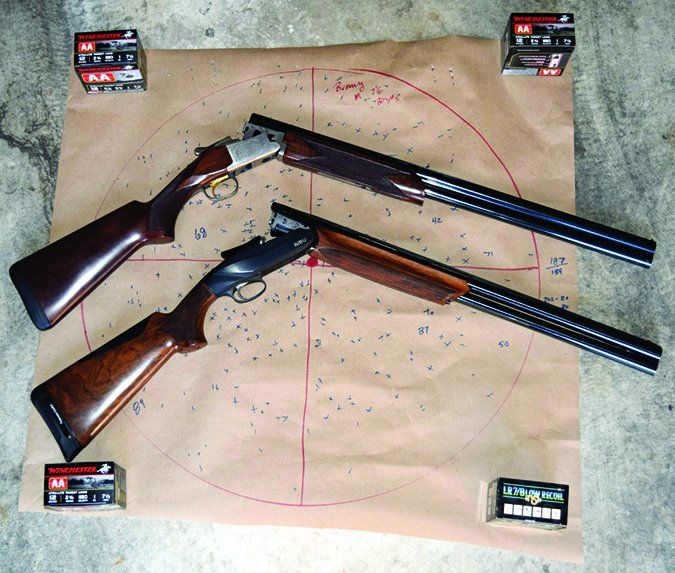
When the new Benelli Model 828U was introduced, devoted fans of Benelli semiautomatics rushed to get more information. At the same time, and with a lot less fanfare, over/under manufacturer Browning Arms introduced a field version of its popular Citori Model 725, which is the latest in the Citori Model 25 line that dates back to the 1970s. A tweak here and a tweak there have been billed as making the new Model 725 Field a top pick for clays and birds.
We should note that the version of the Benelli made available to us was a 26-inch-barrel anodized-aluminum receiver model, while the Browning provided featured 28-inch barrels and a silver nitrite receiver. We made allowances in our testing for the slightly better handling characteristics that are generally attributed to longer barrels and a heavier gun, ensuring these factors did not influence our evaluation.
The ammunition we selected for our testing on the target range and at the patterning board was Winchester AA Extra-Light Target 2.75-inch loads packing 1 ounce of No. 71⁄2 shot with an average muzzle velocity of 1,180 fps. Also, we fired 2.75-inch Nobel Low Recoil Target loads with 7⁄8 ounce of No. 8 shot and an average muzzle velocity of 1,200 fps. Here are our findings:
Browning Citori Model 725 Field No. 0135303004 12 Gauge, $2,470

GUN TESTS GRADE: A
This is another in a long line of solid, fine-handling over and unders. This new field model patterned well, broke targets well, and looked good while doing its job.
| ACTION TYPE | Over/Under |
| CHAMBER SIZE | 3 in. |
| OVERALL LENGTH | 44.75 in. |
| CAPACITY | 2 |
| WEIGHT UNLOADED | 7.75 lbs. |
| BARREL LENGTH | 28 in. |
| BARREL | Polished blue steel, chrome lined |
| RECEIVER | Low profile silver nitride, with roll engraving |
| SAFETY | Non-automatic |
| CHOKE TUBES | Invector DS Flush-Fit (IC, M, F) |
| BUTTSTOCK | Grade II/III checkered walnut, gloss oil finish |
| BUTTSTOCK LENGTH OF PULL | 14.25 in. |
| BUTTSTOCK DROP AT COMB | 1.6 in. |
| BUTTSTOCK DROP AT HEEL | 2.5 in. |
| FOREARM | Grade II/III checkered walnut, gloss oil finish |
| FRONT BEAD | Ivory |
| REAR BEAD | Ivory |
| RIB | 1/4 in. |
| BOTTOM TRIGGER PULL WEIGHT | 4.5 lbs. |
| TOP TRIGGER PULL WEIGHT | 4.25 lbs. |
| TRIGGER RESET | Mechanical |
| WARRANTY | Limited |
| TELEPHONE | (800) 333-3288 |
| SITE | Browning.com |
| MADE IN | Japan |
As noted earlier, this is the latest version of a long line of Browning over-and-unders that have found favor with the shooting public. At first glance, there are only minor differences in the appearance between this field model and its sporting-clays cousin introduced about five years ago. The new model features a rounded forearm designed with a slight palm rest, high-relief engraving on the receiver, and ivory front and mid-bead sights.
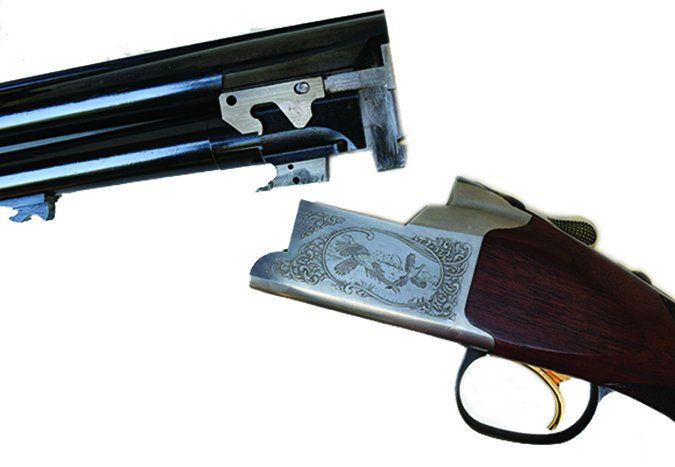
Internally, the Browning has a mechanical trigger system, back-bored barrels with lengthened forcing cones, and the Invector-DS internal choke tube system, with Improved Cylinder, Modified, and Full tubes included with the Field model, the same features introduced when the original Model 725 hit the market.
This field shotgun provided a solid, well-balanced platform for handling clays and birds, as expected. It tipped the scales at 7.75 pounds and measured 44.75 inches in length, with our team finding no fault in its heft or handling ability.
The shotgun’s length of pull was 14.25 inches, with a drop at the comb of 1 5⁄8 inches and a drop at the heel of 2.5 inches. These dimensions are right on the average mark for an out-of-the-box shotgun, and our various team members had no problems adjusting to the fit.
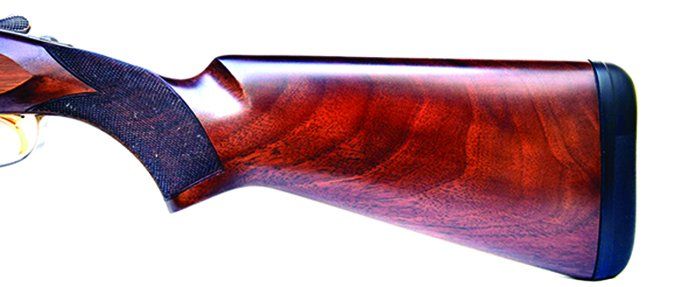
We liked the feel and looks of the checkering on both the pistol grip and the newly designed forearm. Our shooters documented no handling problems in any of our testing.
With birds in the air, we should note we were particularly impressed with the trigger-pull touch-offs of 4.5 pounds for the bottom barrel and 4.25 for the top barrel. The Fire-Lite mechanical triggers in the Model 725 are both smooth and crisp, going the extra step to help a shooter stay on target when touching off a shot.
Our trip to the patterning board before field testing on the clay target range with the Browning was an eye-opener. We have patterned several Browning shotguns featuring the Invector DS (Double Seal) chokes and found the tubes seem to pattern very well. This Model 725 Field was no exception. Firing the Winchester Extra-Lite No. 71⁄2 shot shells at a range of 30 yards, we found the Modified choke in the top barrel produced a 57-43 percent pattern (57 percent above the center and 43 percent below) and the Improved Cylinder choke in the bottom barrel produced a 62-38 percent pattern. Shooting just a little high is exactly what a field shotgun should do to handle rising targets.

We were particularly impressed with the pattern spread, finding a very solid and uniform distribution of hits. Both the Modified and Improved Cylinder tubes delivered just under 40 percent of the strikes within a 20-inch circle around the center of the targets. There were 202 hits in the 20-inch circle with the Modified choke and 164 hits with the Improved Cylinder choke.
This solid, uniform patterning performance with no holes that might allow a clay or bird to escape undamaged was verified on the clay-target range. We smacked most targets with authority. A ragged pattern that might only cause a chip to fly off a clay target is acceptable on the range, but a crippling shot on a bird in the field because of ineffective pellet trauma is not. We found the Browning hit targets hard when the shooter puts the pattern in the right place at the right time. Recoil with the Browning using the two light loads was well within the comfortable range, and spent shells were ejected with authority each and every time — there were no malfunctions of any kind.
Our Team Said: This shotgun, whose predecessors date back more than 40 years, is a true tribute to the solid, reliable, high-quality Browning over-and-unders on the market today. It handled very well on the clay-target course, excelled on the patterning board, and helps a shooter look sharp to his compatriots while serving as a solid shooting tool.

Benelli Model 828U No. 10701 12 Gauge, $2,500
GUN TESTS GRADE: C
Although Benelli has a reputation for producing high-quality semiautomatic shotguns, we found the company’s new over/under was lacking in both appearance and performance. Poor patterns, weak target hits, and uninspiring features all contributed to our low grade for this shooting tool.
| ACTION TYPE | Over/Under |
| CHAMBER SIZE | 3 in. |
| OVERALL LENGTH | 43.5 in. |
| CAPACITY | 2 |
| WEIGHT UNLOADED | 6.5 lbs. |
| BARREL LENGTH | 26 in. |
| BARREL | Crio steel, chrome lined |
| RECEIVER | Anodizd aluminum |
| SAFETY | Automatic |
| CHOKE TUBES | Crio Flush Fit (C, IC, M, IM, F) |
| BUTTSTOCK | AA Grade satin walnut |
| BUTTSTOCK LENGTH OF PULL | 14.75 in. |
| BUTTSTOCK DROP AT COMB | 1.5 in. adjustable |
| BUTTSTOCK DROP AT HEEL | 2.1 in. adjustable |
| FOREARM | Checkered walnut |
| FRONT BEAD | Red optic |
| RIB WIDTH | 3/8 in. (fiber optic) |
| BOTTOM TRIGGER PULL WEIGHT | 4.5 lbs. |
| TOP TRIGGER PULL WEIGHT | 4 lbs. |
| TRIGGER RESET | Inertial |
| WARRANTY | 10-year limited |
| TELEPHONE | (800) 264-4962 |
| SITE | BenelliUSA.com |
| MADE IN | Italy |
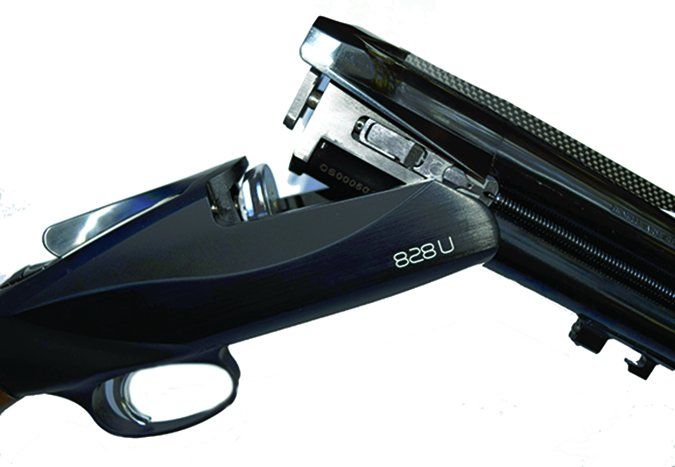
Perhaps because of the well-known reputation of Benelli as the maker of fine semiautomatics, even a casual observer will notice the new Model 828U almost appears to have been constructed with some semiautomatic parts or features. The shotgun just does not have the feel and look of a standard over-and-under. Most noticeable is the shotgun’s patented locking mechanism that incorporates a free-floating locking plate in the front of the aluminum receiver. The plate features four contact points with the barrel and moves forward and backward on springs as the shotgun is opened and closed.
It is designed to provide a stronger, tighter seal, but to our eyes, it looks like something that could be found in a semiautomatic shotgun. While we had no problems working the system, our experience leads us to believe that over time, and after extensive use in the field and on the range, we worry that there may be issues that develop with the mechanism. Time will tell.
The new Benelli also features its Progressive Comfort recoil reduction system, a removable trigger group, Crio free-floating barrels, a carbon-fiber rib and red fiber-optic sight. In addition, the Model 828U has a unique lever that re-cocks the hammers when pushed to the right, rather than relying on opening the action to reset the hammers as in standard over-and-unders.
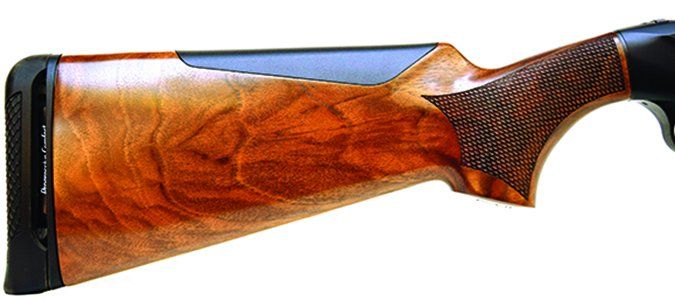
With the lighter aluminum receiver and other features, including the 26-inch barrels, the Model 828U weighed 6.5 pounds and had an overall length of 43.5 inches. Even with the light loads used in the testing, recoil was significantly more noticeable than with shots fired in the Browning. This is a simple function of physics; a lighter gun will deliver more recoil momentum to the shooter’s shoulder than a heavier gun. The trade-off in the field is that most shooters will take a lighter gun that carries better, because just one extra pound adds up over several miles of kicking pheasants up.
The Benelli also failed to eject any of the light loads from the bottom barrel, which caused us to consider whether there was a problem with the impulse-driven ejectors that might require gunsmith work. One of our test-team members scrounged up a heavier load (a 1-ounce, 1,230 feet per second shell) that did eject from the bottom barrel. Our conclusion was that the Model 828U system doesn’t like light loads — not a good thing in a light firearm.
Elsewhere, we thought the stock, forearm, and barrel finish on the Benelli seemed to closely resemble the features of a semiautomatic, rather than exhibiting the typical look and style of an over-and-under in its price range. If a shooter favors the looks and feel of a semiautomatic, the Model 828U may be just the ticket.

Utilizing an inertia trigger system that requires the firing of the first barrel to engage the second, the Model 828U triggers touched off at 4.5 pounds for the bottom barrel and 4 pounds for the top. However, we noticed there was a little creep or spongy feel to the pull with both triggers, unlike the crisp, sharp pull of the Browning. As for the dimensions of the new introduction into the over-and-under market, the drop of the adjustable comb was set at 1.5 inches and drop at the heel was set at 2.25 inches when we assembled the shotgun for testing. The length of pull was 14.75 inches. Overall, our test team members were satisfied with that configuration.
We did find that the balance point of the shotgun was slightly behind the lightweight, aluminum receiver, rather than the preferred point right between the hands as with the Browning. This caused the Benelli to be a little harder to move into targets — similar to the movement required to push a semiautomatic through targets — rather than the glide-through handling of a well-balanced over and under.
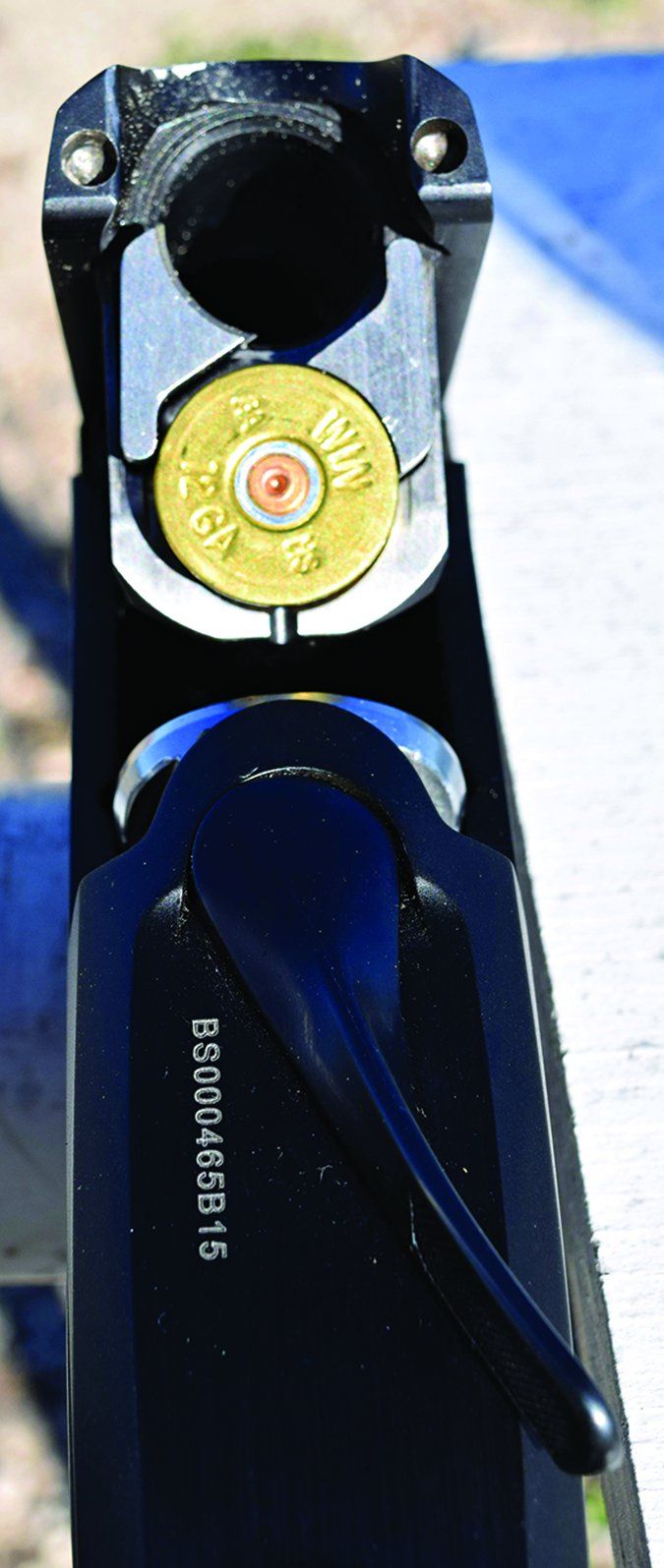
For our firing tests, we set up at the patterning range where we quickly discovered that the Crio Flush Fit chokes (Cylinder, Improved Cylinder, Modified, Improved Modified and Full) included with the package were not a match for the Browning. The modified choke in the top barrel produced a 39-61 percent pattern, with 306 hits (46 percent) in the 20-inch circle around the center. However, 76 percent of the total hits in the 30-inch circle were in the lower left quadrant and there were four, 3-inch holes in the pattern, mainly in the outer 10-inch ring.
Results with the Improved Cylinder choke were substantially worse. That pattern was 13-87 percent, with 153 hits (28 percent) in the 20-inch center circle. There were only 38 pellet hits above the center of the target and several large areas with no strikes at all.
This tendency to shoot low and left went a long way toward explaining why our team’s target busting experience with the Benelli was much less than satisfactory. To consistently break targets, particularly those with any distance on them, we had to hold high and right, not the accepted and typical practice of shooting where you look. We achieved very few hard, solid breaks with either of the two test loads fired at various targets, both close and far, using the Benelli.
Our Team Said: We were disappointed in the looks, feel, and handling ability of Benelli’s first venture into the over-and-under market. Add in the sub-par patterning performance, plus some ineffective target busting time on the range, and our shooters said the new 828U stack-barrel does not live up to the standards of the high-quality semiautomatic firearm innovator.
Written and photographed by Ralph Winingham, using evaluations from Gun Tests team testers.




























Good to see an honest and thorough review… too many around that aren’t. Most don’t have pattern tests.